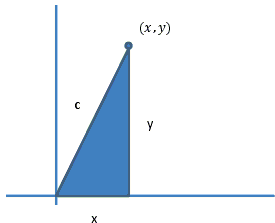Calculus Proof of the Pythagorean Theorem
This proof has been posted by John Molokach.
Begin with a right triangle drawn in the first quadrant. The legs are variables x and y and the hypotenuse is a fixed positive value c, where the vertex of the angle whose sides contain x and c is the origin.

The slope of the line containing c is
and the line perpendicular to the line containing c at
Now consider the set of all points (x, y) that are a fixed distance c from the origin where
All possible points (x, y) in this scenario will lie on the solution curve to
Finding a general solution to the differential equation
∫ydy = -∫xdx
y²/2 = -x²/2 + D
x² + y² = E; E = 2D.
Now using an initial condition (x, y) = (c, 0) we have:
0² + c² = E
c² = E.
So we have the particular solution x² + y² = c². Pick arbitrary values for
Critique
Before looking for faults, let me shorten the proof.
First of all, starting with a triangle (x, y, c) and stating that lines with slopes y/x and - x/y are perpendicular had no effect on the proof. The opening paragraph, the picture and the two following sentences are unnecessary and may be setting the wrong kind of anticipation. That they have becomes apparent from the next sentence.
We are going to write, then solve a differential equation and see what comes out. Until we have done that, "the set of all points at a fixed distance c from the origin" appears to drop out of the blue and is, again, not used in the proof, but to mislead.
What remains? For every point (x, y) in the plane, define a direction with the slope -x/y. This is called a vector field. Solutions to the equation we are setting up will be the integral curves of that field, i.e., curves whose tangents at every point have the slopes define by the vector field, -x/y, in this case.
We solve the equation and find that the general form of the solution is
Unless the distance d(x, y) from the origin to point
There is nothing that can be said as to the meaning of the equation x² + y² = c². For example, the distance
The fact that a differential equation led to curves
Important Note
Some time later John has submitted a corrected version of the proof that appears to avoid the pitfalls of circular reasoning.
|Pythagorean Theorem| |Contact| |Front page| |Contents| |Geometry|
Copyright © 1996-2018 Alexander Bogomolny71544952
